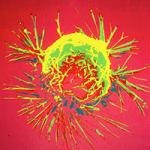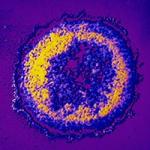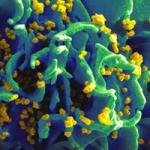
Research Topics
Heterodimeric IL-15 (hetIL-15) cytokine in cancer immunotherapy
Understanding of the cellular mechanisms controlling expression shed new light in the biology and regulation of IL-15, led to the identification of the bioactive heterodimeric form of IL-15 and provided methods for the efficient production and clinical application of this cytokine (Bergamaschi, J. Biol. Chem. 283:4189, 2008; Bergamaschi, Blood 120:e1-8, 2012; Bergamaschi, Cancers 13, 2021). We have shown that hetIL-15 greatly increases lymphocyte infiltration in several tumors in mouse models and in macaques, suggesting a general method to increase lymphocyte infiltration, which is associated with anti-tumor activity. We have performed first-in-human clinical trials of hetIL-15 in metastatic cancers (Conlon, J. Immunother. Cancer e003388, 2021) and also in combination with anti-PD-1 check point inhibitor (NCT02452268; collaboration with Novartis). My lab has key contributions in the development and NIH-patenting of the best-in-class heterodimeric IL-15 molecule (hetIL-15) for clinical development. Our many patents led to clinical trials in NCI Clinical Center and by Novartis and other companies. A version of heterodimeric IL-15 was approved by FDA for cancer immunotherapy of non-muscle invasive bladder cancer together with BCG vaccine.
hetIL-15 is extensively studied in mouse tumor models where we demonstrated the rapid interaction of lymphoid and myeloid cell networks after hetIL-15 treatment resulting in changes in numbers and migration of different cell populations. Extensive transcriptomics and proteomics analysis has revealed additional pathways affected by hetIL-15 (Bergamaschi, J. Immunother. Cancer 8:e000599, 2020; Bergamaschi, Cancers 13, 2021). We have studied the effects of hetIL-15 on the number and properties of Dendritic Cells (DC), which increase in tumors upon hetIL-15 treatment. DC participate in a network of cells that are induced during hetIL-15 treatment and in turn support more recruitment of effector cells in tumor sites. Studies in mouse orthotopic models show that DC populations correlate with tumor regression and reveal additional beneficial effects of hetIL-15 in inducing or enhancing long term protective immune response against tumors (Stellas, Cell Rep., 42:112501, 2023). Thus, hetIL-15, a cytokine directly affecting lymphocytes and inducing cytotoxic cells, has also an indirect rapid and significant effect on the recruitment of myeloid cells, initiating a cascade for tumor elimination though innate and adoptive immune mechanisms.
Combination treatments enhance tumor elimination in mouse cancer models
We have combined hetIL-15 with additional drugs and anti-cancer procedures such as surgery using orthotopic and GEMM (Genetically Modified Mouse Models). These studies have revealed additive or synergistic properties of certain combinations, which are translatable to the clinic.
We study the intratumoral lymphocyte fitness and functional ability. Our results show that intratumoral lymphocytes may not have optimal fitness for killing cancer cells. We discovered that hetIL-15 enhances the metabolic activity of intratumoral lymphocytes, explaining its enhancing anti-tumor activity. In addition, we have discovered drug treatments that further enhance intratumoral lymphocyte fitness enhancing also therapeutic effects. Therefore, our strategies are (i) to find and implement methods in different cancer types that enhance agonistic effects of the immune system and especially of the cytotoxic cells, and (ii) address antagonistic effects of the specific tumors to counter the effects of the immune system. Our hypothesis is that the agonistic effects will be in general similar for many tumors, whereas a multitude of antagonistic effects are already known for different tumors. Optimal combination therapies have to be tailored to these different tumor-specific mechanisms.
Anti-metastatic effects of hetIL-15
One important property of hetIL-15 is the strong activity against metastatic disease. It is therefore essential to incorporate this activity in therapeutic regimens, because metastatic disease is by far the major cause of death in cancer. Use of hetIL-15 as neo-adjuvant therapy, in combination with other immunotherapy agents and other drugs and procedures, should be a major area of exploration and we have established the model systems to accomplish this.
hetIL-15 in HIV cure studies
In addition to cancer immunotherapy, IL-15 has generated strong interest for clinical use to treat HIV infection, especially in protocols targeting viral eradication or a functional cure. The use of IL-15 as an immune therapeutic agent against HIV infection is based on its effects as a growth factor and key regulator of cytotoxic responses mediated by both the innate (NK cells) and the adaptive (CTL) arms of the immune system. Importantly, hetIL-15 treatment promotes the entrance of cytotoxic (GrzB+) CD8+ T cells in the B cell follicles, areas within the LN where CTL are typically excluded and where SIV/HIV infected follicular helper CD4+ T cells reside. hetIL-15 treatment led to significant decrease in cell-associated viral RNA within the LN as well as in plasma viremia in SHIV infected macaques (Watson, PLoS Pathog. 14:e1006902, 2018).
In collaborative efforts, we further reported that a IL-15 transcriptional signature response to a viral RhCMV/SIV vaccine strongly correlated with protection (Barrenas, PLoS Pathog. 17:e1009278, 2021). We have expanded this concept and are testing the contribution of a combinatorial treatment including hetIL-15 in reducing reservoir in the SIV infected ART-treated macaques. The hypothesis generated by our experiments and those of other groups suggest that hetIL-15 has multiple effects in the context of chronic HIV infection: It can activate infected CD4 cells inducing virus production, which may make infected quiescent cells visible to the immune system. It induces cytotoxic CD8 and NK cells and at high levels induces their migration into the LN and germinal centers. It appears that this transient effect of hetIL-15 in relocating cytotoxic cells in the areas of virally infected CD4 may not have permanent effects, because of the inactivation of cytotoxic cells in certain areas, including sanctuary cites where infected cells cannot be eliminated, at least completely, and they have the chance to be maintained despite the increased cytotoxic cells. Further understanding of the additional mechanisms modulating access of cytotoxic cells to different sanctuary compartments will enhance our ability to develop better strategies to address both chronic debilitating infections and cancers, such as lymphomas and myelomas. hetIL-15 may become an important component of drug cocktails allowing deeper remissions and cures due to the enhancement of cytotoxic arm of the immune system.
Development and testing of nucleic acid-based vaccine for therapeutic cancer vaccine and HIV indications
The development of a safe and effective vaccine to prevent HIV infection and to improve treatment strategies aiming to reduce/eliminate the virus reservoir are currently major projects that have rejuvenated vaccinology and have contributed major breakthroughs and new technology resulting in more effective and safer vaccine methods for prevention and therapy. We developed the key methodology to express HIV antigens at high level from RNA/codon-optimized genes, which allows efficient antigen production when expressed from simple DNA plasmids or as part of recombinant viral vectors. Immunogenicity is augmented in the presence of cytokines, i.e., IL-12 DNA co-administration. We optimized DNA delivery with the result of achieving systemic and mucosal immune responses. Using DNA+Protein combination vaccines, the magnitude, breadth and longevity of the immune responses increased resulting in significant improved protection from infection in the SIV/SHIV NHP model (Patel, PNAS 110:2975, 2013; Jalah, PLoS One 9:e91550, 2014; Felber, Cell Rep. 31:107624, 2020).
These efforts led to a vaccine that showed a 67% reduction in per exposure acquisition risk of macaques relative to unvaccinated controls (Felber, Cell Rep. 31:107624, 2020). These data have important implications for combination vaccine modalities, which are typically administered in separate anatomical sites. We hypothesize that optimization of immunogens to better target the rare B cell precursor, combined with the co-administration of vaccine vector and protein in same draining lymph nodes could provide an immunological advantage over current protocols, resulting in significantly improved protection.
Our current project explores a potential breakthrough in the development of simple DNA vaccine formulations that produce strong antibody and cellular immune response. Formulations of DNA vaccines in lipid nanoparticles resulted in very high levels of antigen-specific CD8 cytotoxic T cells in addition to strong neutralizing antibodies (Karaliota, iScience, in press 2025). Development of high CD8 responses is essential for cancer therapeutic vaccines, where we know that most published methods do not achieve high levels of CD8. Our work comparing mRNA/LNP vaccines to DNA vaccines has shown that DNA vaccination achieves higher cellular responses, including cytotoxic CD8. Therefore, the new methodology we propose for DNA vaccines may have multiple uses for therapeutic and prophylactic vaccines. It is important to expand these data and assess the different formulations in comparative studies.
Test of DNA vaccine with SARS-CoV-2 Antigens generates strong cellular and neutralizing antibody respond.
We applied our experience in developing HIV vaccines towards SARS-CoV-2 (Rosati, PLoS Pathog. 17:e1009701, 2021). The different Spike DNA-based vaccine regimens induced robust antibody and T cell responses able to effectively mediate protection and to control SARS-CoV-2 infection in macaques. Importantly, a vaccine regimen comprising simultaneous co-immunization of DNA and protein at the same anatomical site showed was more effective than DNA alone in inducing protective immune responses and controlling SARS-CoV-2 infection. We are now exploring novel DNA delivery methods to achieve better immunity of DNA-only vaccine to simplify the vaccine platform. Of particular interest is the suggestion that Antibody with neutralizing activity can be recalled 2 years post vaccination, indicating the maintenance of long-lived plasma cells, which has not been able to achieve with mRNA vaccines.
COVID-19 vaccine in naïve individuals and cancer patients
We have been studying the immune response of COVID-19 cohorts longitudinally to characterize the nature and longevity of immune response (Rosati, Am. J. Hematol. 97:E3, 2022; Rosati, Front. Immunol. 12:793953, 2021; Thomopoulos, Viruses 1:1844; 2021; Terpos, Eur. J. Intern. Med. 89:87, 2021; Pappa, Microorganisms 9:806, 2021; Terpos, Microorganisms 8:1885, 2020). The analysis of natural infection is providing important information for the design of vaccine strategies. To characterize adaptive and innate immune responses in SARS-CoV-2 vaccinated persons, we identified early responses to vaccination that are important in shaping both humoral and cellular protective immunity (Bergamaschi, Cell Rep. 36:109504; 2021; Bergamaschi, Front. Immunol. 3:899972, 2022).
An important priority for our group is the impact of SARS-CoV-2 in cancer patients, which are more vulnerable to the virus. Patients with B cell malignancies under treatment can have persistent viremia at high levels and need additional care and protection. We characterized the cytokine and chemokine responses to BNT162b2 mRNA (Pfizer/BioNtech) vaccinations in antigen-naïve and in previously COVID-19-infected individuals, as well as in patients with hematological malignancies (NCT04743388). We identified a systemic signature including IL-15, IFN-gamma, IP-10/CXCL10, TNF-alpha and IL-6. Transient increases in IL-15 and IFN-gamma levels early after boost correlated with Spike antibody levels, supporting their use as biomarkers of effective humoral immunity development in response to vaccination. We are expanding our research of the development of adaptive and innate immune responses upon COVID-19 vaccination to other cancer cohorts.
Development and clinical testing of Conserved Element (CE) vaccine
Considering the diversity of the different HIV clades, we are focusing on highly conserved regions of HIV to induce immune responses to nearly invariable proteome segments, essential for the function of the virus, while excluding responses to variable and potentially immunodominant "decoy" epitopes (Kulkarni, PLoS One 9:e86254, 2014; Kulkarni, PLoS One 9:e111085, 2014; Hu, Hum. Vaccin. Immunother. 14:2163, 2018). The method of priming with CE DNA and boosting with CE+gag DNA maximizes both magnitude and breadth (Kulkarni, PLoS One 9:e86254, 2014; Kulkarni, PLoS One 9:e111085, 2014; Hu, J. Immunol. 197:3999, 2016). Thus, we identified a novel and effective strategy to maximize responses against Gag and provide a novel strategy to shift the immunodominance hierarchy and to induce robust immune responses to subdominant epitopes, effectively targeting the Achilles' heel of the virus.
We have translated the HIV CE DNA vaccine concept to the clinic in the HIV Vaccine Trial Network (HVTN)/DAIDS/NIAID-supported clinical trial (HVTN 119; NCT03181789), in a phase I/IIb trial (ACTG A5369; NCT03560258) supported by the AIDS Clinical Trial Group, in HIV-infected persons under HAART, and trial NCT04357821 supported by amfAR and UCSF (open Q4, 2020) as part of a combinatorial therapy to induce an HIV remission. HVTN 119 and A5369 combine several of milestones (DNA expression vectors, adjuvants, and delivery) we have achieved over many years in vaccine development. Together, these trials will allow us to explore the translation of our data from mice and macaques to humans and initial data analysis supports our achievement of this goal. These two trials offer another unique opportunity to directly compare the same vaccines in two different cohorts, naïve and HIV-infected on ART, using the same methodology, and will provide novel insight in the development in immune responses comparing the two cohorts.
Additional efforts to focus immune responses to relevant Env parts were made: We developed novel molecules to direct and focus humoral immune responses to V2 domain of the HIV gp120 Env. We reported that priming with this DNA altered the hierarchy of humoral immune responses to V2 region epitopes, providing a method for more efficient induction and maintenance of V2-specific Env Abs associated with reduced risk of HIV infection (Devasundaram, J. Virol. 95:e01193, 2020). We are testing the hypothesis whether these responses translate to better protection in the macaque model.
We have further expanded the CE vaccine regimen in collaboration with CureVac, Inc. as an mRNA/lipid nanoparticle (LNP) formulation in the macaque model (Valentin, Front. Immunol. 13:945706, 2022). The mRNA/LNP formulation induced robust, durable antibody responses but low adaptive T-cell responses, a feature also shared with the current COVID-19 mRNA vaccine. On the other hand, the mRNA/LNP vaccine was able to strongly boost pre-existing cellular response suggesting that it could be useful in heterologous prime/boost modality and in immune therapeutic interventions against HIV infection or other chronic human diseases. Our studies have provided useful information about different nucleic acid vaccine platforms and guide further clinical development.
Biography
Dr. Felber received her Ph.D. in molecular biology from the University of Bern, Switzerland. After carrying out postdoctoral studies in the Laboratory of Biochemistry, NCI Bethesda, she joined the Molecular Mechanisms of Carcinogenesis Laboratory, the NCI contract Basic Research Program, in 1985. In 1990, Dr. Felber established the Human Retrovirus Pathogenesis Group. In 1998, Dr. Felber received her tenure appointment and, in 1999, she joined the Center for Cancer Research, NCI. Her work focuses on the mechanisms of gene regulation, use of cytokines as therapeutic modalities in cancer and AIDS, and the development of DNA-based therapeutic cancer and HIV vaccines.
Selected Publications
- Kalams SA, Felber BK, Mullins JI, Scott HM, Allen MA, De Rosa SC, Heptinstall J, Tomaras GD, Hu J, DeCamp AC, Rosati M, Bear J, Pensiero MN, Eldridge J, Egan MA, Hannaman D, McElrath MJ, Pavlakis GN, HIV Vaccine Trials Network 119(HVTN 119) Study Team. Focusing HIV-1 Gag T cell responses to highly conserved regions by DNA vaccination in HVTN 119. JCI Insight. 2024;9(18).
- Stellas D, Karaliota S, Stravokefalou V, Angel M, Nagy BA, Goldfarbmuren KC, Bergamaschi C, Felber BK, Pavlakis GN. Tumor eradication by hetIL-15 locoregional therapy correlates with an induced intratumoral CD103(int)CD11b(+) dendritic cell population. Cell Rep. 2023;42(5):112501.
- Conlon K, Watson DC, Waldmann TA, Valentin A, Bergamaschi C, Felber BK, Peer CJ, Figg WD, Potter EL, Roederer M, McNeel DG, Thompson JA, Gupta S, Leidner R, Wang-Gillam A, Parikh NS, Long D, Kurtulus S, Ho Lee L, Chowdhury NR, Bender F, Pavlakis GN. Phase I study of single agent NIZ985, a recombinant heterodimeric IL-15 agonist, in adult patients with metastatic or unresectable solid tumors. J Immunother Cancer. 2021;9(11).
- Bergamaschi C, Terpos E, Rosati M, Angel M, Bear J, Stellas D, Karaliota S, Apostolakou F, Bagratuni T, Patseas D, Gumeni S, Trougakos IP, Dimopoulos MA, Felber BK, Pavlakis GN. Systemic IL-15, IFN-γ, and IP-10/CXCL10 signature associated with effective immune response to SARS-CoV-2 in BNT162b2 mRNA vaccine recipients. Cell Rep. 2021;36(6):109504.
- Bergamaschi C, Pandit H, Nagy BA, Stellas D, Jensen SM, Bear J, Cam M, Valentin A, Fox BA, Felber BK, Pavlakis GN. Heterodimeric IL-15 delays tumor growth and promotes intratumoral CTL and dendritic cell accumulation by a cytokine network involving XCL1, IFN-γ, CXCL9 and CXCL10. J Immunother Cancer. 2020;8(1).
Related Scientific Focus Areas




Molecular Biology and Biochemistry
View additional Principal Investigators in Molecular Biology and Biochemistry

This page was last updated on Thursday, September 11, 2025